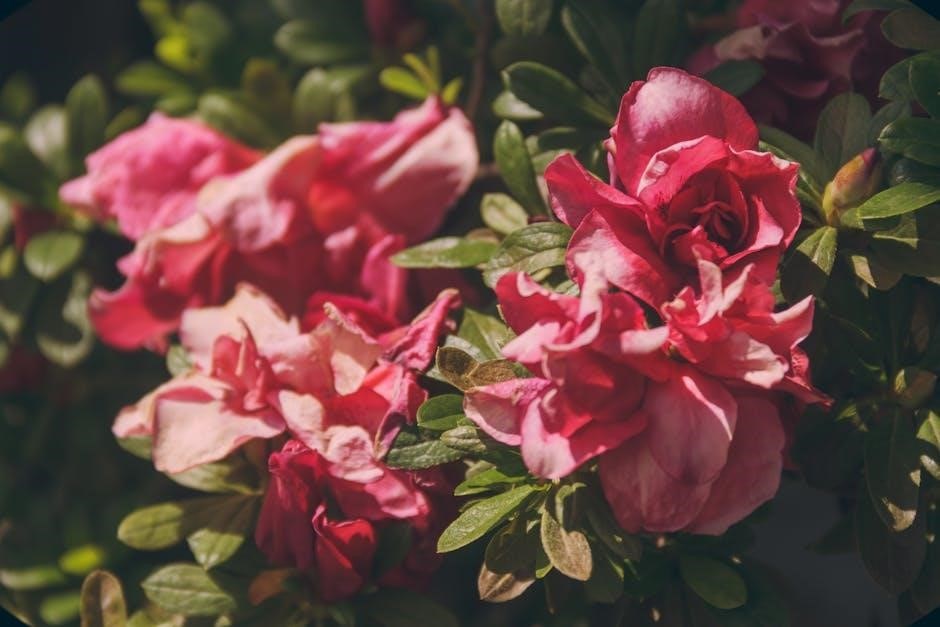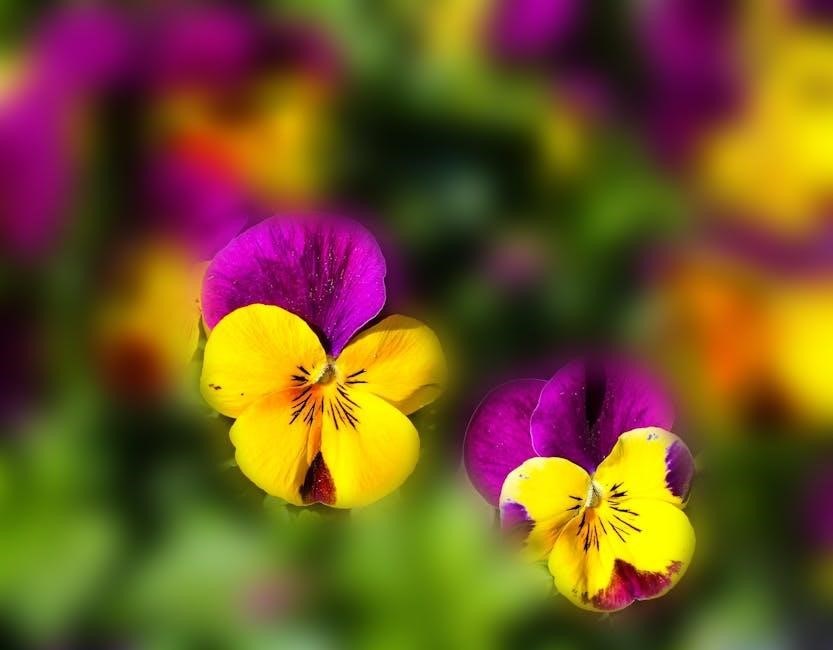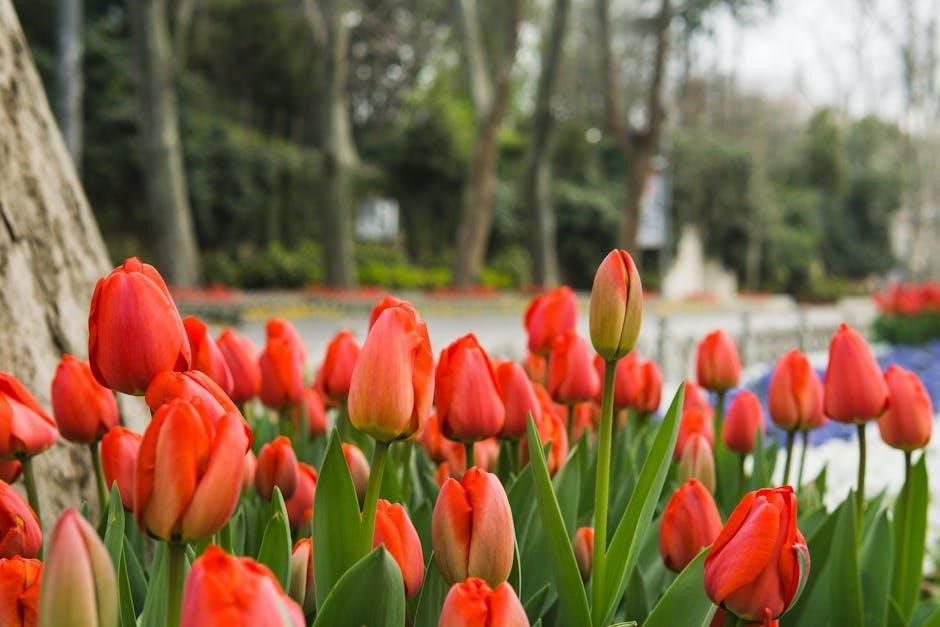Zone 9a offers a long growing season with warm temperatures, ideal for vibrant blooms. This guide helps gardeners choose the best flowers, shrubs, and bulbs for their climate, ensuring thriving gardens year-round.
1.1 Understanding USDA Hardiness Zone 9a
USDA Hardiness Zone 9a is a specific region defined by the U.S. Department of Agriculture, characterized by average annual extreme minimum temperatures ranging from 20°F to 25°F (-7°C to -4°C). This zone spans parts of states like California, Texas, and Florida, where warm winters and long growing seasons prevail. Zone 9a is ideal for growing a wide variety of plants, including flowers, shrubs, and bulbs, due to its mild climate. Gardeners in this zone can enjoy planting year-round, with minimal frost concerns. The USDA Hardiness Zone Map helps determine which plants are most likely to thrive in the local climate, making it an essential tool for successful gardening in Zone 9a;

1.2 Importance of Zone-Specific Planting Guides
Zone-specific planting guides are crucial for ensuring gardening success, as they provide tailored advice for thriving in local climate conditions. These guides help gardeners select plants suited to their area’s temperature, soil, and weather patterns, reducing the risk of planting failures. For Zone 9a, where winters are mild and summers are warm, understanding the best plants and planting times is essential. By following a zone-specific guide, gardeners can maximize bloom duration, improve plant health, and create vibrant, sustainable gardens. Additionally, these guides often include tips on attracting pollinators and extending the flowering season, making them invaluable for both experienced gardeners and newcomers to Zone 9a.
Best Flowers for Zone 9a
Zone 9a offers ideal conditions for a wide variety of vibrant flowers, including perennials like lantana and salvias, and annuals such as zinnias and marigolds, ensuring colorful blooms year-round.
2.1 Perennial Flowers for Zone 9a
Perennial flowers are a fantastic choice for Zone 9a gardens, offering durability and vibrant blooms year after year. Lantana, with its clusters of small, fragrant flowers, thrives in the warm climate. Salvias, known for their tall spikes of color, attract pollinators and bloom profusely. Coneflowers, such as Echinacea, are drought-tolerant and add a striking presence to any garden. Black-eyed Susans, with their bright yellow petals and dark centers, are another excellent option, providing long-lasting color. These perennials are well-suited to Zone 9a’s long growing season and require minimal maintenance. Planting them in well-draining soil and full sun ensures healthy growth and continuous blooming, making them a perfect addition to any garden in this zone.
2.2 Annual Flowers for Zone 9a
Annual flowers are a great way to add vibrant color and life to Zone 9a gardens. Zinnias are an excellent choice, thriving in the warm climate and blooming from spring to fall. They come in a variety of bright colors and are easy to grow, making them perfect for attracting pollinators. Marigolds are another popular option, offering bold hues and requiring minimal care. They also repel pests, adding an extra benefit to your garden. Petunias are ideal for adding a pop of color in containers or beds, with their trumpet-shaped blooms flourishing in Zone 9a’s sunny conditions. These annuals are perfect for gardeners looking to create dynamic, ever-changing displays throughout the growing season.
When to Plant Flowers in Zone 9a
Zone 9a’s long growing season allows for two main planting periods: spring and fall. Spring is ideal for bulbs and perennials, while fall suits cool-season annuals and pre-chilled bulbs for vibrant blooms.
3.1 Spring Planting in Zone 9a

Spring is an ideal time to plant flowers in Zone 9a, as the warm temperatures and long growing season support vibrant blooms. Bulbs like tulips and daffodils thrive when planted in late winter to early spring, while perennials such as zinnias and marigolds excel in Zone 9a’s climate. The mild winters allow for earlier planting compared to cooler zones, giving gardeners a head start. Soil preparation is key, ensuring well-draining soil with adequate nutrients. Spring planting also offers the opportunity to grow a wide variety of annuals and perennials, creating colorful displays that last throughout the season. With proper care, Zone 9a gardens can enjoy extended blooming periods, making spring a prime time for planting.

3.2 Fall Planting in Zone 9a
Fall planting in Zone 9a is a great opportunity to establish flowers and bulbs before the cooler winter months. The mild winters in this zone allow gardeners to plant a variety of species, including bulbs like tulips and daffodils, which can be planted in late fall for spring blooms. Perennials such as lilies and daylilies also thrive when planted in the fall, as the soil retains warmth, promoting root growth. Annuals like pansies and violas can be planted in early fall to add color to the garden during the cooler seasons. Fall planting in Zone 9a also provides a chance to refresh gardens after the summer heat, ensuring a vibrant display of flowers throughout the year. Proper soil preparation and timing are key to successful fall planting in this zone.

How to Plant Flowers in Zone 9a
Choose flowers suited to Zone 9a’s climate, plant at the right time, and follow care practices like watering and mulching to ensure healthy, vibrant blooms.
4.1 Soil Preparation for Flower Planting
Proper soil preparation is essential for thriving flowers in Zone 9a. Test your soil pH and amend it if necessary, as most flowers prefer a slightly acidic to neutral soil (6.0–7.0). Add organic matter like compost or well-rotted manure to improve soil structure and fertility. Ensure good drainage by loosening compacted soil or mixing in sand. For bulbs, till the soil to a depth of 12–18 inches to accommodate their deep roots. Mulch around plants to retain moisture and suppress weeds. Avoid over-fertilizing, as this can lead to excessive foliage growth at the expense of blooms. Specific flowers may require additional soil amendments, so research their needs before planting.
4.2 Sunlight Requirements for Zone 9a Flowers
Zone 9a’s warm climate means most flowers thrive in full sun to partial shade. Aim for at least 6–8 hours of direct sunlight daily for vibrant blooms. Zinnias, marigolds, and lantanas excel in full sun, while impatiens and violas prefer partial shade. Be mindful of intense afternoon sun, which can stress plants. For sensitive varieties, provide afternoon shade or use mulch to protect roots from excessive heat. Balancing sunlight exposure ensures healthy growth and abundant flowering in Zone 9a gardens.

Bulbs to Plant in Zone 9a
Zone 9a’s mild winters and warm summers make it ideal for planting bulbs like tulips, daffodils, and hyacinths, which thrive in this climate and produce vibrant blooms.
5.1 Spring-Flowering Bulbs for Zone 9a
Zone 9a’s mild winters and warm springs make it perfect for spring-flowering bulbs like tulips, daffodils, and hyacinths. These bulbs thrive in the region’s climate, producing vibrant blooms that attract pollinators. Plant tulips and daffodils in late winter or early spring for stunning spring displays. Hyacinths and grape hyacinths (Muscari) also excel, offering fragrant and colorful blooms. Ranunculuses and Dutch iris are additional options, providing a variety of colors and textures. Ensure well-draining soil and full sun to partial shade for optimal growth. Plant bulbs at the right depth and water moderately. These bulbs are low-maintenance and reward gardeners with a spectacular show of spring flowers, enhancing the beauty of Zone 9a gardens.
5.2 Fall-Planted Bulbs for Zone 9a
Fall is an ideal time to plant bulbs in Zone 9a, as the cooler temperatures allow bulbs to establish roots before spring. Tulips, daffodils, and hyacinths are popular choices, but they may require pre-chilling in Zone 9a’s mild winters. Plant them in late fall for a vibrant spring display. Ranunculuses and Dutch iris are also excellent options, thriving in the region’s climate. Garlic and shallots can be planted in fall for a summer harvest. Fall-planted bulbs benefit from well-draining soil and full sun to partial shade. Water moderately after planting and during growth. These bulbs add color and texture to gardens, attracting pollinators and enhancing biodiversity. Proper care ensures a stunning bloom, making fall planting a rewarding experience for Zone 9a gardeners.

Shrubs for Zone 9a Gardens
Zone 9a gardens benefit from shrubs like Abelia and Azalea, offering colorful foliage and fragrant blooms. These low-maintenance options thrive in warm climates, providing vibrant displays from spring to fall.
6.1 Evergreen Shrubs with Flowers
Evergreen shrubs are a fantastic choice for Zone 9a gardens, offering year-round foliage and stunning blooms. Abelia is a popular option, known for its vibrant, fragrant flowers that bloom from spring to fall. Its low-maintenance nature makes it ideal for gardeners seeking beauty without constant upkeep. Another standout is Azalea, which boasts vibrant, colorful blooms and thrives in Zone 9a’s warm climate. These shrubs provide structure and beauty to gardens, attracting pollinators and adding fragrance to the air. By incorporating evergreen shrubs, gardeners can enjoy consistent color and texture, enhancing their outdoor spaces throughout the seasons.

6.2 Deciduous Shrubs with Vibrant Blooms
Deciduous shrubs add dynamic beauty to Zone 9a gardens, offering bursts of vibrant color during their blooming seasons. Viburnum is a standout choice, producing clusters of white or pink flowers in spring and attracting pollinators. Spirea is another excellent option, with its cascading blooms in shades of pink, white, or purple, creating a stunning display. These shrubs typically lose their leaves in winter, making way for new growth in spring. Their ability to thrive in Zone 9a’s warm climate and well-drained soil makes them ideal for borders or hedges. By incorporating deciduous shrubs, gardeners can enjoy seasonal changes and vibrant blooms that enhance the garden’s aesthetic throughout the year.

Maintenance Tips for Zone 9a Flower Gardens
Regular watering, proper drainage, and deadheading are essential for vibrant blooms. Fertilize seasonally and prune plants to maintain health and encourage continuous flowering in Zone 9a gardens.
7.1 Watering Requirements for Zone 9a Flowers
Zone 9a gardens require consistent watering due to the warm climate. Most flowers need about 1-2 inches of water weekly, either from rain or irrigation. Check soil moisture by inserting a finger into the soil up to the knuckle; water only if it feels dry. Avoid overhead watering, which can lead to fungal diseases. Instead, use soaker hoses or water at the base of plants. Mulching around plants helps retain moisture and regulate soil temperature. Overwatering can cause root rot, while underwatering may stress plants. Adjust watering schedules during cooler or rainy periods to prevent waterlogged soil. Proper hydration ensures healthy growth and vibrant blooms in Zone 9a flower gardens.
7.2 Deadheading and Pruning for Healthier Blooms
Deadheading and pruning are essential practices for maintaining vibrant blooms in Zone 9a gardens. Deadheading involves removing spent flowers to redirect the plant’s energy toward producing new blooms. This technique works well for annuals like zinnias and perennials such as roses. Pruning, on the other hand, helps control plant shape, promotes healthy growth, and encourages profuse flowering. For perennials, prune back leggy stems in early spring or after blooming. Annuals benefit from light trimming to maintain compactness. Use clean, sharp tools to prevent spreading diseases; Regular deadheading and pruning also improve air circulation, reducing the risk of fungal infections. These practices ensure your Zone 9a flower garden remains lush, vibrant, and full of color throughout the growing season.
Benefits of Planting Zone 9a Flowers
Planting Zone 9a flowers attracts pollinators, supports biodiversity, and extends the blooming season. Vibrant blooms enhance garden beauty, creating a welcoming habitat for wildlife and a colorful display year-round.
8.1 Attracting Pollinators to Your Garden
Planting a variety of Zone 9a flowers attracts pollinators like bees, butterflies, and hummingbirds, essential for biodiversity. Flowers rich in nectar and pollen, such as zinnias and shrubs like abelia, draw these beneficial insects. Incorporating native plants and vibrant blooms ensures a constant food source, supporting pollinator health. Planting in clusters and avoiding pesticides further enhances pollinator-friendly habitats, fostering a thriving ecosystem in your garden.

8.2 Extending the Blooming Season in Zone 9a
Zone 9a’s long growing season allows gardeners to enjoy blooms nearly year-round. By strategically planting spring-flowering bulbs like tulips and daffodils, which thrive after a winter chill, and fall-planted bulbs like hyacinths, you can extend the blooming season. Incorporating perennials that bloom in late summer and fall, such as zinnias and abelia shrubs, ensures continuous color. Annuals like marigolds and petunias add vibrant displays during warmer months. This layered approach creates a dynamic garden with flowers blooming at different times, providing a constant display of beauty and attracting pollinators throughout the year.
Zone 9a’s long growing season and warm climate make it an ideal location for a diverse and vibrant flower garden. By selecting the right perennials, annuals, bulbs, and shrubs, gardeners can enjoy blooms year-round. Proper soil preparation, sunlight management, and consistent watering are key to thriving plants. Deadheading and pruning maintain healthy growth and encourage more blooms. Planting a mix of spring and fall flowers extends the blooming season, creating a dynamic garden. Attracting pollinators and enjoying a colorful landscape are just a few benefits of gardening in Zone 9a. With the right strategies, gardeners can maximize their space and enjoy a stunning floral display throughout the year.
Leave a Reply
You must be logged in to post a comment.